Chief Justice of Hungary
The chief justice[1][2][3] (Hungarian: királyi személynök,[4] Latin: personalis praesentiae regiae in judiciis locumtenens,[5] German: Königliche Personalis)[1] was the personal legal representative of the King of Hungary, who issued decrees of judicial character on behalf of the monarch authenticated with the royal seal, performed national notarial activities and played an important role in the organisation of lawyers training. Later the chief justice was the head of the Royal Court of Justice (Hungarian: Királyi Ítélőtábla, Latin: Tabula Regia Iudiciaria) and the Tribunal of the Chief Justice (Hungarian: személynöki szék, Latin: sedes personalitia), the highest legal forum of civil cases.
| Chief Justice of the Kingdom of Hungary | |
|---|---|
 | |
| Residence | Buda (1514–1536; 1784–1867) Pressburg (1536–1784) |
| Appointer | King of Hungary |
| Precursor | Secret Chancellor |
| Formation | 15th century (1464) |
| First holder | Janus Pannonius |
| Final holder | István Melczer |
| Abolished | 1867 |
| Succession | President of the Curia Regia |
| Part of a series on |
| Great Officers of State in the Kingdom of Hungary |
|---|
.svg.png.webp) |
| Kingdom of Hungary |
Origins
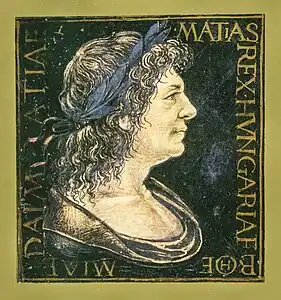
The office of personalis evolved since the early 15th century within the royal chancellery. In the beginning, the king was represented by the secret chancellor in the judiciary (judge of personal presence).[6] The first known chief justice was Janus Pannonius, a Croato-Hungarian humanist poet who returned to Hungary after finishing studies at the University of Padua in 1458, the coronation year of Matthias Corvinus. Pannonius served as chief justice until 1459, when he was elected as the Bishop of Pécs. Until the 1464 reform, the complete list of chief justices is unknown. It is certain that Albert Vetési, Bishop of Veszprém held the office for a short time around 1460.
From the 1370s, during the reign of Louis I, the lord chancellor also had a judicial function. He became judge of special presence (Latin: specialis presentia regia). This position was held by Roman Catholic prelates, therefore the judicial function was performed by their deputies. Consequently, a dual judicial system existed in the Kingdom of Hungary until the administrative reform of 1464.[7]
Formation
Matthias Corvinus (formally Matthias I), after restoring the Holy Crown of Hungary for 60,000 ducats, was allowed to retain certain Hungarian counties with the title of king and was crowned legitimately on 29 March 1464. After the second and valid coronation, Matthias began to reorganize the administrative and judicial structure.[8] He merged the two courts ("special" and "personal judicatures") and established the institution of chief justice as a full-fledged judge to the head of the Royal Court. The chancellery was also unified and the new office of "lord- and vice-chancellor" lost all of its judicial functions.[7]
The Tribunal of the Chief Justice also established where the so-called "towns of chief justice" (Hungarian: személynöki város) forwarded those appeals concerning litigations. The tribunal chaired by the chief justice functioned as appellate court for the "towns of treasurer" (Hungarian: tárnoki város) too. According to the Tripartitum (1514) five settlements were towns of chief justice: Székesfehérvár, Esztergom, Lőcse (Levoča), Kisszeben (Sabinov) and Szakolca (Skalica). The status meant some independence, so was sought after by the towns. The Quadripartitum (1551), which never came to force, also mentions the seven mining towns of Upper Hungary as towns of chief justice.
Functions and development
The Act LXVIII of 1486 listed the chief justice among the "ordinary judges" beside the palatine and the judge royal. The chief justice also served as keeper of the monarch's judicial seal. In contrast, the secret chancellor assumed his role in the arbitration only on special occasions. The ordinary judges were able to make judgements on any matter and also could appoint deputies and masters of judgement. In practice, this meant that the judicial power decoupled itself from the executive branch (the king). The Act XLII of 1492 (during the reign of Vladislaus II) also confirmed these authorities.[6]
.png.webp)
During the first decades the position was held by ecclesiastical dignitaries. Thomas Drági was the first secular office-holder between 1486 and 1490. There had been a growing demand to fill the position by secular jurists and professionals on a permanent basis. That finally occurred at the beginning of the 16th century when the Act IV of 1507 decreed that the office must be occupied by a secular person with legal practice.[6] Despite the new law the influential and powerful cardinal Tamás Bakócz chose his prelate relatives for the office. The importance of the office of chief justice was made clear when Buda became the permanent residence of the Tribunal of the Chief Justice. The Act LV of 1514 also emphasized the appointment of secular office-holders. After that the secular and ecclesiastical elite agreed with each other and István Werbőczy, creator of the Tripartitum was appointed later in 1516.[9]
After the battle of Mohács (1526) the reigning chief justice Miklós Thuróczy swore allegiance to Ferdinand I. As a result, the other elected king, John Zápolya also appointed a chief justice for his own royal court in the person of Benedek Bekényi.[6]

Charles III divided the Curia Regia into two courts in 1723: the Tabula Septemviralis (Court of the seven) and the Tabula Regia Iudiciaria (Royal Court of Justice). The latter functioned under the direction of the chief justice, in the case of prevention, of the elder Baron Court. The Tabula Regia Iudiciaria was constituted of two prelates, two Barons of the Court, two deputy judge advocates of the Kingdom: the vice Palatine, the deputy judge advocate of the Curia Regia, four prothonotaries, four assessors of the Kingdom, four assessors of the archdiocese, four adjunctive assessors.[5]
The chief justice also had a political function: he became speaker of the occasionally convened lower house of the Diet of Hungary. During the Habsburg-dominated kingdom a customary law emerged whereby jurists to the office of chief justice were chosen from the lesser nobility, however later sometimes aristocrats were also appointed to that position. The Tribunal of the Chief Justice was one of the positions used for the development, patronage and rise of a new aristocracy which was loyal to the House of Habsburg. For the new "official nobility" the position of chief justice was the springboard to obtain higher positions (mostly judge royal, president of the Hungarian Court Chamber, vice-chancellor).[5]
János Zarka opened and presided over the last feudal Diet of 1848. During the Hungarian Revolution of 1848 the position became vacant. After the defeat of the War of Independence Francis Joseph I applied neo-absolutist governance ("Bach system") and integrated the Kingdom of Hungary to the Habsburg Empire. Due to the fall of the Bach system in 1861, the position of chief justice, among others, was revived again and István Melczer took the office. According to the Austro-Hungarian Compromise of 1867 the judicial system had been converted and modernized; the chief justice lost all of its features and the position was officially discontinued.
List of known chief justices
Kingdom of Hungary (1000–1538)
| Term | Portrait | Incumbent | Monarch | Notes | Source |
|---|---|---|---|---|---|
| 1458 | 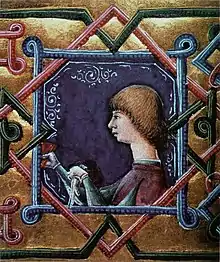 |
Janus Pannonius (John Csezmicei) |
Matthias Corvinus | humanist poet; later bishop of Pécs (1459–1472) | [10][11] |
| 1458–1459 |  |
Albert Vetési | Matthias Corvinus | from the gens Kaplon; also vice-chancellor (1458), secret chancellor (1458–1459), bishop of Veszprém (1458–1486) | [11][12][13] |
| 1459–1464 |  |
Nicholas Bodó | Matthias Corvinus | personalis presentia | [11] |
| 1464–1465 |  |
Albert Hangácsi | Matthias Corvinus | 1464 judicial and administrative reform; also bishop of Csanád (1457–1466) | [14] |
| 1465–1466 |  |
Stephen | Matthias Corvinus | first term; provost of Kalocsa | [14][15] |
| 1468–1470 |  |
Gabriel Matucsinai | Matthias Corvinus | also vice-chancellor (1468–1471), later archbishop of Kalocsa and lord chancellor (1471–1478) | [14][16][17][18] |
| 1470–1472 |  |
Stephen | Matthias Corvinus | second term | [14][19] |
| 1472–1483 |  |
Ladislaus Karai | Matthias Corvinus | provost of Buda; also vice-chancellor (1471–1476); patron of András Hess (Chronica Hungarorum); resigned due to illness | [15][20] |
| 1483–1484 |  |
Peter Váradi | Matthias Corvinus | also lord and secret chancellor (1480–1484), archbishop of Kalocsa (1480–1501); imprisoned | [21][22] |
| 1485–1486 |  |
Lucas Apáti | Matthias Corvinus | provost of Eger | [6][23] |
| 1486 | .jpg.webp) |
John Filipec | Matthias Corvinus | Czech: Jan Filipec z Prostějova; also bishop of Olomouc (1484–1490) | [24][25] |
| 1486–1490 |  |
Thomas Drági | Matthias Corvinus | first secular chief justice;[26] Drági Compendium | [17][23][27] |
| 1490–1494 |  |
Stephanus Crispus (Stephen Fodor) |
Vladislaus II | nephew of Urban Nagylucsei; also bishop of Syrmia (1490–1494) | [27][28][29] |
| 1495–1501 |  |
Domokos Kálmáncsehi | Vladislaus II | also bishop of Várad (1495–1501); Breviarium (1481) | [15][30] |
| 1502–1503 |  |
Lucas Szegedi | Vladislaus II | bishop of Bosnia (1490–1493), treasurer (1490–1492), bishop of Zagreb (1500–1510) | [31][32] |
| 1503–1512 |  |
István Erdődy | Vladislaus II | brother of Tamás Bakócz; remained in office despite Act IV of 1507; also bishop of Syrmia (1503–1505) and bishop of Nyitra (1505–1512) | [9][27] |
| 1513–1514 |  |
János Erdődy | Vladislaus II | nephew of Tamás Bakócz; appointed despite Act IV of 1507; also bishop of Zagreb (1512–1518); resigned | [9][27][33] |
| 1516–1525 | 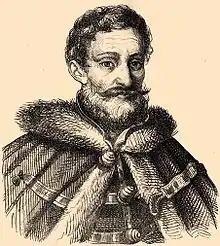 |
István Werbőczy | Louis II | creator of the Tripartitum (1514); later palatine (1525–1526), chancellor for John I (1526–1540) | [9][34] |
| 1525–1527 |  |
Miklós Thuróczy | Louis II Ferdinand I John I |
also master of judgement for judge royal (1525–1527); he supported Ferdinand I after the battle of Mohács (1526) | [4][35] |
Hungarian Civil War (1526–1538)
For Ferdinand I
|
For John I
|
16–17th century
| Term | Portrait | Incumbent | Monarch | Notes | Source |
|---|---|---|---|---|---|
| 1542–1544 | Vacancy | [4] | |||
| 1544–1562 |  |
Mihály Mérey | Ferdinand I | later palatinal governor (1562–1572); creator of the Quadripartitum (1551) | [4][38] |
| 1562–1570 |  |
János Zomor | Ferdinand I Maximilian |
[4][39] | |
| 1570–1571 |  |
Damján Aranyáni | Maximilian | [4][6] | |
| 1572–1585 |  |
András Vitál | Maximilian Rudolf |
master of judgement for palatine (1569–1572) | [4][35] |
| 1585–1587 | Vacancy | [4] | |||
| 1587–1603 |  |
János Joó | Rudolf | dismissed due to his involvement in the show trial against István Illésházy (1603) | [4][15] |
| 1604–1616 |  |
János Lippay | Rudolf Matthias II |
one of the signatories of the treaty of Vienna (1606) | [4][40] |
| 1617–1625 |  |
Benedek Pákay | Matthias II Ferdinand II |
also a royal councillor (1625) | [4][41] |
| 1625–1627 |  |
Mózes Cziráky | Ferdinand II | [4][6] | |
| 1627–1628 |  |
István Patachich | Ferdinand II | also acting ban of Croatia (1626–1627) | [4][41] |
| 1629–1630 |  |
Gáspár Tersztyánszky | Ferdinand II | [4][35] | |
| 1631–1649 |  |
Tamás Mikulich | Ferdinand II Ferdinand III |
[4][41] | |
| 1650–1665 |  |
György Orossy | Ferdinand III Leopold I |
also a royal councillor (1650–1665) | [4][41] |
| 1665–1666 |  |
Gáspár Heölgyi | Leopold I | converted to Roman Catholicism; his widow later married chief justice Esterházy | [4][42] |
| 1666–1667 |  |
János Szakmárdy | Leopold I | also master of judgement for Croatia, Slavonia and Dalmatia, vice-ispán of Varaždin County, royal councillor (1666–1667) | [4][31] |
| 1667–1670 | 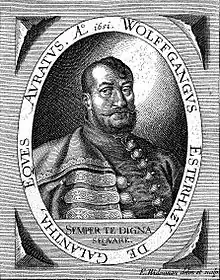 |
Farkas Esterházy | Leopold I | from the House of Esterházy; member of the committee which investigated the Wesselényi conspiracy (1670) | [4][27] |
| 1670–1677 |  |
János Majthényi | Leopold I | [4][43] | |
| 1677–1679 | Vacancy | [4] | |||
| 1679–1693 |  |
István Orbán | Leopold I | also member of the Gubernium (1681–1693) | [4][41] |
| 1693–1699 |  |
János Maholányi | Leopold I | also master of judgement for chief justice (1695–1699) | [40][44] |
18–19th century
| Term | Portrait | Incumbent | Monarch | Notes | Source |
|---|---|---|---|---|---|
| 1699–1705 |  |
Ferenc Klobusiczky | Leopold I | also ispán of Arad (1699–1702) and Sáros Counties (1701–1708); he joined Kuruc during the Rákóczi's War of Independence (1705) | [40][44] |
| 1705–1707 | 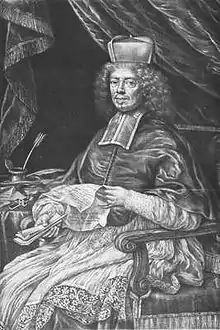 |
Leopold Karl von Kollonitsch | Joseph I | also archbishop of Esztergom and lord chancellor (1695–1707); leading figure of the Hungarian counter-reformation | [45] |
| 1708–1723 |  |
János Horváth-Simonchich | Joseph I Charles III |
[42][44] | |
| 1723 |  |
László Hunyady | Charles III | also titular counselor for chancellery (1722–1723); died before taking office | [15][44] |
| 1724–1731 |  |
György Száraz | Charles III | [31][44] | |
| 1731–1748 | .jpg.webp) |
Antal Grassalkovich | Charles III Maria Theresa |
confidant of Maria Theresa; also ispán of Arad County (1744–1751); created baron (1736) and count (1743); appointed president of the Hungarian Court Chamber (1748) | [42][44] |
| 1748–1762 |  |
György Fekete | Maria Theresa | also ispán of Arad and Zaránd Counties (1751–1788); created count (1758); appointed vice-chancellor (1762), later judge royal (1773) | [44][46] |
| 1762–1765 |  |
Ferenc Koller | Maria Theresa | also ispán of Bars County (1759–1787); dismissed | [40][44] |
| 1765–1779 |  |
Jakab Szvetics | Maria Theresa | [35][44] | |
| 1779–1789 |  |
Péter Végh | Maria Theresa Joseph II |
also ispán of Baranya County (1782–1792); appointed master of the treasury (1789), later judge royal (1795) | [44][47] |
| 1789–1795 |  |
József Ürményi | Joseph II Leopold II Francis |
also ispán of Bács County (1790–1802); later appointed governor of Galicia (1801), judge royal (1806); Ratio Educationis (1777) | [44][48] |
| 1795–1801 |  |
József Felsőbüki Nagy | Francis | speaker of the Diet of 1796 | [41][44] |
| 1802–1808 |  |
András Semsey | Francis | also ispán of Ugocsa (1803–1807) and Abaúj Counties (1807–1814); appointed president of the Hungarian Court Chamber (1808) | [41][44] |
| 1808 |  |
István Aczél | Francis | dismissed due to heavy resistance against his operation; appointed vice-chancellor (1808) | [6][44] |
| 1808–1821 |  |
György Majláth, Sr. | Francis | Jesuit cleric (1767–1773); also ispán of Tolna County (1811–1821) | [43][44] |
| 1821–1825 |  |
Zsigmond Szőgyény | Francis | father of László Szőgyény-Marich, Sr.; appointed vice-chancellor (1825) | [31][44] |
| 1825–1831 |  |
György Majláth, Jr. | Francis | son of György Majláth, Sr.; also ispán of Hont County (1828–1843), later judge royal (1839–1848), speaker of the House of Magnates and royal governor (1848) | [44][49] |
| 1831–1833 | 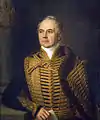 |
Sándor Mérey | Francis | also ispán of Somogy County (1831–1845) | [41][44] |
| 1833–1839 |  |
Pongrác Somssich | Francis Ferdinand V |
also ispán of Baranya County (1835–1846) | [31][44] |
| 1839–1847 |  |
István Szerencsy | Ferdinand V | also ispán of Arad County (1836–1842); appointed master of the cupbearers (1847) | [31][44] |
| 1847–1848 |  |
János Zarka | Ferdinand V | speaker of the Diet of 1848 | [35] |
| 1848–1861 | Vacancy during the Hungarian Revolution of 1848 and after its suppression | ||||
| 1861–1867 |  |
István Melczer | Francis Joseph I | last chief justice of the Kingdom of Hungary | [43] |
See also
Footnotes
- Fallenbüchl 1988, p. 147.
- Szende 1999, p. 448.
- Gergely 2000, pp. 133–134.
- Fallenbüchl 1988, p. 107.
- Fallenbüchl 1988, p. 29.
- Markó 2006, p. 336.
- Bertényi 1996.
- Kubinyi 2004, p. 40.
- Fraknói 1899.
- Markó 2006, p. 444.
- Bónis 1971, table VI.
- Markó 2006, p. 333.
- Kubinyi 2000, p. 12.
- Kubinyi 2004, p. 32.
- Markó 2006, p. 339.
- Markó 2006, p. 319.
- Kubinyi 2000, p. 19.
- Bónis 1971, p. 254.
- Bónis 1971, pp. 225–226.
- Véber 2009, p. 26.
- Véber 2009, p. 34.
- Markó 2006, p. 332.
- Véber 2009, p. 68.
- Markó 2006, p. 309.
- Bónis 1971, p. 19.
- Matucsinai was also secular when he held the office of chief justice, however later became a Roman Catholic prelate. Kubinyi 2000, p. 19.
- Markó 2006, p. 337.
- Véber 2009, p. 102.
- Bónis 1971, p. 334.
- Kubinyi 1957, p. 30.
- Markó 2006, p. 343.
- Kubinyi 1957, p. 32.
- Bónis 1971, pp. 319–320.
- Markó 2006, p. 259.
- Markó 2006, p. 344.
- Markó 2006, p. 257.
- Markó 2006, p. 250.
- Markó 2006, p. 240.
- Markó 2006, p. 345.
- Markó 2006, p. 340.
- Markó 2006, p. 342.
- Markó 2006, p. 338.
- Markó 2006, p. 341.
- Fallenbüchl 1988, p. 108.
- Markó 2006, p. 316.
- Markó 2006, p. 280.
- Markó 2006, p. 297.
- Markó 2006, p. 296.
- Markó 2006, p. 285–286.
References
- (in Hungarian) Bertényi, Iván (1996). A magyar királyi udvar tisztségviselői a középkorban ("Officials of the Hungarian royal court in the Middle Ages"). Rubicon, 1996/1–2.
- (in Hungarian) Bónis, György (1971). A jogtudó értelmiség a Mohács előtti Magyarországon ("Hungarian intelligentsia having legal expertise in the period before the battle of Mohács"). Akadémiai Kiadó, Budapest.
- (in Hungarian) Fraknói, Vilmos (1899). Werbőczi István (1458–1541). Magyar Történeti Életrajzok, Magyar Történelmi Társulat, Budapest.
- Gergely, András (2000). The Hungarian State.Thousand years in Europe. Korona Publishing House, Budapest.
- (in Hungarian and German) Fallenbüchl, Zoltán (1988). Magyarország főméltóságai ("High Dignitaries in Hungary"). Maecenas Könyvkiadó. ISBN 963-02-5536-7.
- (in Hungarian) Horváth, Gyula Csaba (2011): A 18. századi magyar főméltóságok családi kapcsolati hálózata.
- (in Hungarian) Kubinyi, András (1957). "A kincstári személyzet a XV. század második felében." Tanulmányok Budapest Múltjából. Vol. 12. (1957). 25–49.
- (in Hungarian) Kubinyi, András (2000). "Vitéz János és Janus Pannonius politikája Mátyás uralkodása idején" ("The Politics of János Vitéz and Janus Pannonius During the Reign of King Matthias"). In: Bartók, István – Jankovits, László – Kecskeméti, Gábor (ed.). Humanista műveltség Pannóniában. Művészetek Háza, University of Pécs.
- (in Hungarian) Kubinyi, András (2004). "Adatok a Mátyás-kori királyi kancellária és az 1464. évi kancelláriai reform történetéhez." Publicationes Universitatis Miskolciensis Sectio Philosophica. Vol. 9. No. 1. (2004). 25–58.
- (in Hungarian) Markó, László (2006). A magyar állam főméltóságai Szent Istvántól napjainkig: Életrajzi Lexikon ("Great Officers of State in Hungary from King Saint Stephen to Our Days: A Biographical Encyclopedia"). 2nd edition, Helikon Kiadó. ISBN 963-547-085-1
- Szende, Katalin (1999). "Was there a bourgeoisie in medieval Hungary?" In: Nagy, Balázs – Sebők, Marcell (ed.). ... The Man of Many Devices, Who Wandered Full Many Ways... Central European University Press. ISBN 963-9116-67-X Cloth.
- (in Hungarian) Véber, János (2009). Két korszak határán, Váradi Péter pályaképe és írói életműve. Pázmány Péter Catholic University, Ph.D. thesis.
Laws and rules
- (in Hungarian) 1486. évi LXVIII. törvénycikk
- (in Hungarian) 1492. évi XLII. törvénycikk
- (in Hungarian) 1507. évi IV. törvénycikk
- (in Hungarian) 1514. évi LV. törvénycikk
- (in Hungarian) 1608. évi (k. e.) III. törvénycikk
- (in Hungarian) 1609. évi LXX. törvénycikk
- (in Hungarian) 1751. évi VI. törvénycikk
- (in Hungarian) 1764/65. évi V. törvénycikk
